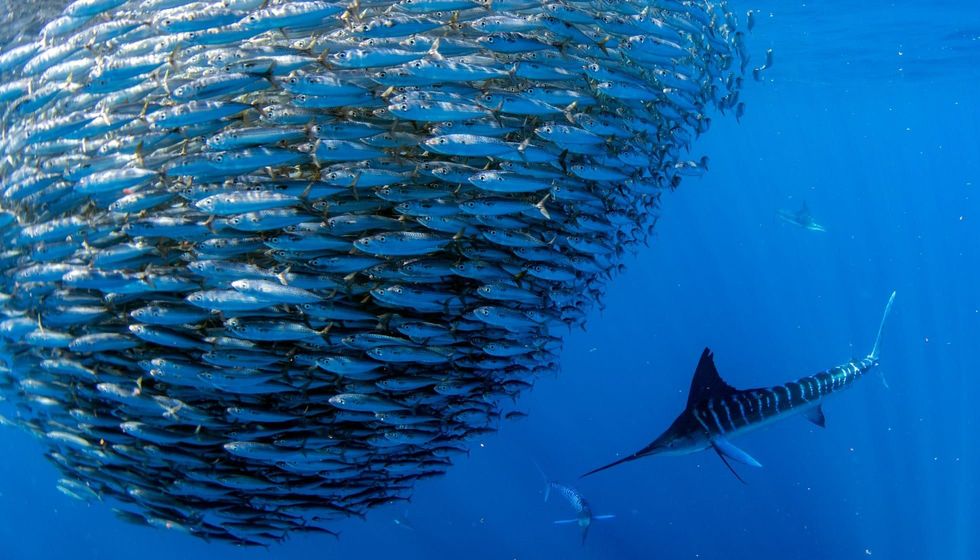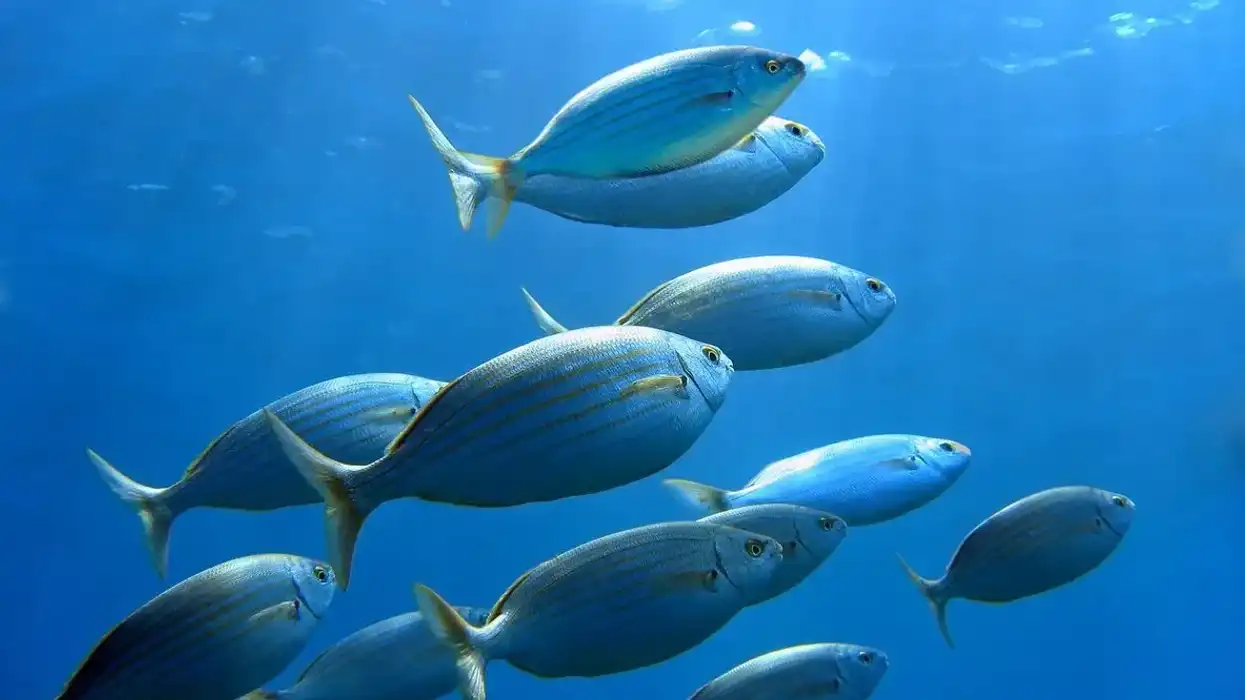The Pacific and Indian Oceans are home to plenty of fascinating fish. We can find one of the world's fastest fish species within this population- the striped marlin.
Known for the distinct stripes on their backs, this fish has gained stardom for being one of the fastest swimmers around. Their swimming skills come in handy when the species embark on their seasonal migration.
Part of the billfish group, this marlin has a long and pointed bill. This results in the fish mostly flashing and striking their prey, in contrast to the tactics of impalation by other members of the billfish group. However, not all is well for this species.
Due to their tender meat, fisheries around the world hunt striped marlin. As a result, their numbers are thought to be decreasing in the wild.
If you want to know more about them, read on. If you enjoy this article, check out Sawfish and Billfish.
Striped Marlin Interesting Facts
What type of animal is a striped marlin?
The spearfish striped marlin (Tetrapturus audax) is a highly migratory billfish species commonly found in the Pacific and Indian Oceans. Kajikia audax is another scientific name for the striped marlin species.
What class of animal does a striped marlin belong to?
Belonging to the billfish species, the striped marlin is part of the class Actinopterygii. This is the class that houses all ray-finned fishes.
They are sometimes placed under two different genera. Kajikia is the genus that contains all billfish species that inhabit tropical and temperate ocean and sea waters. Tetrapturus is a genus that comprises different schools of marlins roaming in the sea and ocean water.
How many striped marlins are there in the world?
Due to the fish not being studied in a lot of detail, the total number of this type of billfish in the world is not known.
Where does a striped marlin live?
Mainly inhabiting the coastal regions and waters, this member of the billfish species is found in abundance in the central Pacific Ocean and the Indian Ocean. They have been seen and caught in the waters of California, central Mexico, and Hawaii.
This marlin species also roam around the body of water surrounding Australasia and Japan. Striped marlins usually live around the upper layer of the ocean and along the water's surface, where they can go and catch prey like tuna and mackerel.
What is a striped marlin's habitat?
Striped marlins are known to live in the pelagic zones of the Pacific Ocean (especially the central Pacific) and other tropical coastal regions. It has been found that their numbers depend on how far they live from the coasts.
Research papers have cited that the population density of the spearfish is directly proportional to their distance in the pelagic waters from the coastal regions. This member of the Billfish family is highly migratory.
Primarily inhabiting the northern and central Pacific, the striped marlin is known to migrate towards the tropical equator in winter, while the opposite occurs in summer.
This blue fish also prefers waters with an optimum temperature within the range of 77-85 F (25-29 C). They usually roam around near the surface of the pelagic water and can be found at a depth of around 700 ft (213 m).
Who does a striped marlin live with?
The striped marlin is a solitary animal that lives in the pelagic zone of the tropical oceans. They are not seen in schools of their kind unless it is during the breeding and spawning seasons.
Despite being the most widely distributed billfish and marlin species, you will not find two fish of this species very close to each other. Some reports say that many striped marlin fish can come together when they catch a good amount of food near the surface that usually consists of schools of tuna fish.
How long does a striped marlin live?
Striped marlins have been observed to have a lifespan between eight and 10 years.
How do they reproduce?
Due to these fish migrating at regular intervals, not much is known about their spawning and reproduction. However, we can still gather a little information about it.
The spawning season is perhaps the only time that the striped marlins band together. Marine biologists believe that male and female fish communicate by changing their colors during spawning.
Due to the presence of chromatophores on its body, this fish can change their coloration to a shade of lavender or pinkish-white from its native blue coloration. The striped marlin fish is known to spawn primarily during the summer.
It is said this fish can release 500,000 eggs at once. Annually, this number reaches anywhere between 11 and 29 million, with the Australian government reporting it to be around 120 million.
What is their conservation status?
Due to the hunting of this Pacific fish using pelagic longline gear by fisheries worldwide, the Striped marlin is classified as Near Threatened in the Red List by the International Union For Conservation Of Nature. Within different fishing species, striped marlin has also found its way into the Greenpeace International SeaFood Red List.
Striped Marlin Fun Facts
What do striped marlins look like?

*Please note that this is an image of a Blue Marlin, not a Striped Marlin specifically. If you have a royalty-free image of a Striped Marlin, then please let us know at hello@kidadl.com
For the Pacific striped marlin species, it is quite evident that the defining physical feature is the blue stripes on their bodies. These blue stripes often lead them to be confused with the blue marlin.
However, the nairagi (as it is called in Hawaii) has a lighter blue coloration on its stripes when compared to the blue marlin. Going by studies, the nairagi can have around 12 to 16 blue stripes or bars.
This bony Pacific fish also has similarities with the sailfish, with the dorsal fin being a differentiating factor. The dorsal fin of this marlin species is smaller compared to the dorsal fin of the sailfish.
The striped marlin also has a pair of ventral fins. The underside of the body and the fins are silvery-white in coloration.
The bill and the jaw of this species of fish are unique. Among all the billfish, this species has the longest and thinnest bill.
The lower jaw of this fish is also quite pointed, with its upper jaw extending as well to form a pointed spear-like appearance. Due to their spindle-shaped frame, this fish can travel around quite smoothly in the water.
How cute are they?
To define the striped marlin as a cute fish wouldn't be fitting. With their spear-shaped bill and jaws, the Hawaii nairagi cannot be called adorable.
How do they communicate?
This fish can communicate via the contraction and expansion of pigmented cells called chromatophores, which turn the stripes of the Hawaii nairagi from blue to lavender. The striped marlin fish can also sense chemicals in the water due to enhanced olfactory senses, which helps the fish in finding mates and food.
The lateral line in this fish plays an important role in its communication. The line is sensitive to changes in pressure and makes the marlin aware of its surrounding.
How big is a striped marlin?
The nairagi is quite a big fish concerning its length. There is slight sexual dimorphism, with males being smaller than females.
The length of the fish varies between the range of 5 to 13 ft (3.9 m), with the longest caught nairagi recorded at 14 ft (4.2 m). In comparison, it is half the size of an average killer whale.
How fast can a striped marlin swim?
The striped marlin is thought to be one of the fastest swimmers, making it difficult to catch using live bait and bait bags. The swimming speed of the nairagi hovers around 50 mph (80 kph).
How much does a striped marlin weigh?
The country of New Zealand is the place where some of the heaviest striped marlins have been caught. On average, a caught striped marlin weighs around 250-450 lb (113-204 kg). The weight of the females is more than males. However, off the Kiwi coasts, the world's heaviest striped marlin was caught and weighed 494 lb (224 kg).
What are the male and female names of the species?
No specific names are given to the males and females of this species.
What would you call a baby striped marlin?
Like all fish, young striped marlins are called fry.
What do they eat?
Being opportunistic predators, the striped marlins feed on sardines, tuna, mackerel, and other smaller fish. They catch these fish along the upper layers of ocean waters.
Are they poisonous?
No, this species of fish is not poisonous.
Would they make a good pet?
The striped marlin is a fish that is hardly ever kept in captivity, thankfully. Thus, it can be safe to say that they would not make great pets.
Did you know...
In Hawaii, the local name for the fish is A'u.
This fish is caught very often because they make for an excellent seafood delicacy. One can catch and get them hooked very easily using live bait like small tuna.
Orcas eat striped marlins.
Are striped marlins endangered?
The nairagi is nearly threatened due to excessive fishing and destruction of habitat. Many people often go to New Zealand to catch this fish.
What are the four fastest fish in the world?
The four fastest fish are the black marlin found around the Australian coast; the second and third are the sailfish and the striped marlin, with both inhabiting the Indian and Pacific Oceans. The fourth-fastest is the wahoo fish found in tropical waters around the world.
Here at Kidadl, we have carefully created lots of interesting family-friendly animal facts for everyone to discover! Learn more about some other fishes, including the pinfish and the capelin.
You can even occupy yourself at home by drawing one of our striped marlin coloring pages.










